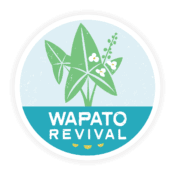About Wapato Revival
Established
in 2014
Wapato, Sagittaria latifolia
The Willamette River Basin is Oregon’s largest watershed as it covers over 11,500 square miles and includes over 13 major tributaries. Tackling how to work with invasives over such a large area involves an extensive collaborative effort.
In 2014, a group of natural resources and conservation professionals representing diverse government agencies, universities, soil and water conservation districts, watershed councils, non-profits, and other organizations throughout the Willamette Basin came together to form the Willamette Aquatic Invasives Network (WAIN). WAIN uses a collaborative approach to technologies, scientific data, and best practices management.
Working together, WAIN members identified the need to develop an action plan for the Willamette River focused on addressing the impacts of AIS. This plan, “Wapato Revival”, was developed to provide guidance for WAIN participants and other professionals on where and how to most effectively prioritize protection and restoration of habitats, and which species and sites to focus on for AIS control work. Wapato Revival incorporates a shared vision to help secure funding, and provide tools to accelerate and improve outreach, research, and on-the-ground efforts, while fostering coordination and communication between stakeholders, and implementing strategic actions aimed at protecting and restoring aquatic and riparian ecosystems and water quality.
The moniker, “Wapato Revival” intentionally points positive, reframing and rebranding WAIN’s concerns about nonn-native species taking over healthy native ecosystems. Wapato (Sagittaria latifolia) is a native plant that grows abundantly throughout the Willamette Valley in off-channel habitats and reflects the importance of native vegetation and landscapes that support diverse and healthy aquatic ecosystems. Wapato Revival reflects WAIN’s action plan to collaboratively and strategically address the issue of AIS to restore aquatic habitats in the Willamette River Basin.
Through a collaborative process, six goals were identified as part of the Wapato Revival Plan:
- GOAL 1: Prevent the introduction and establishment of new AIS to the Willamette Basin by supporting EDRR efforts.
- GOAL 2: Minimize the harmful ecological, economic, human health, and recreation impacts of AIS patches through containment and effective management.
- GOAL 3: Restore aquatic and adjacent riparian habitat to benefit native species and enhance the function of aquatic ecosystems.
- GOAL 4: Apply public education and outreach tools to prevent the introduction of new AIS and to bring increased awareness to the importance of protecting natural resources in the Willamette River Basin.
- GOAL 5: Promote research projects that aim to address a number of questions about AIS pathways of introduction, distribution, impacts, and management options.
- GOAL 6: Foster continued coordination and communication between natural resource managers, scientists, funders, landowners, Indigenous people, and other community members.
Mission
The purpose of Wapato Revival is to galvanize collaboration to implement strategic actions aimed at protecting and restoring aquatic and riparian ecosystems and water quality in the Willamette Basin.
Vision
Restored healthy riparian and aquatic habitats and floodplain functionality in the Willamette watershed.
Values
- Collaboration and partnership
- Informed efforts through education and current data
- Prioritized and strategic implementation
- Healthy ecosystems and thriving native species


